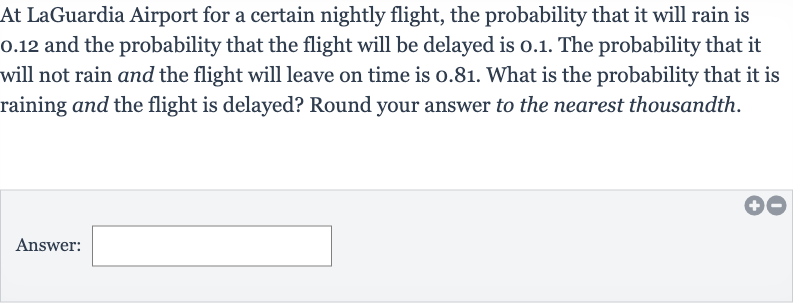AI tutor
Welcome to Bytelearn!
Let’s check out your problem:

At LaGuardia Airport for a certain nightly flight, the probability that it will rain is . and the probability that the flight will be delayed is .. The probability that it will not rain and the flight will leave on time is . . What is the probability that it is raining and the flight is delayed? Round your answer to the nearest thousandth.Answer:
Full solution
Q. At LaGuardia Airport for a certain nightly flight, the probability that it will rain is . and the probability that the flight will be delayed is .. The probability that it will not rain and the flight will leave on time is . . What is the probability that it is raining and the flight is delayed? Round your answer to the nearest thousandth.Answer:
- Events Denoted: Let's denote the events as follows:R: It will rain.D: The flight will be delayed.NR and OT: It will not rain and the flight will leave on time.We are given the following probabilities:We need to find the probability that it is raining and the flight is delayed, which is .
- Find : First, we need to find the probability that it will rain or the flight will be delayed, which is . We can use the complement of the probability that it will not rain and the flight will leave on time, which is . Since is the complement of , we have:
- Use Inclusion-Exclusion Principle: Now, we can use the Inclusion-Exclusion Principle to find . The principle states:We already found and we are given and , so we can solve for :
More problems from Find probabilities using the addition rule
QuestionGet tutor help
QuestionGet tutor help
QuestionGet tutor help
QuestionGet tutor help
QuestionGet tutor help
QuestionGet tutor help
QuestionGet tutor help
QuestionGet tutor help
QuestionGet tutor help
